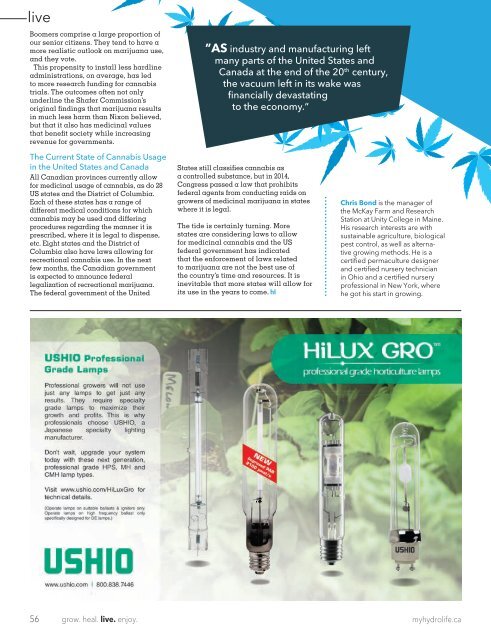Hydrolife Magazine April/May 2017 (Canada Edition)
To know where you’re going, you have to know where you’ve been. The adage rings true for the modern cannabis industry, which is why this issue of Hydrolife takes a look back at the roots of marijuana and how the plant has traveled through history in North America (History of Cannabis Part II).
To know where you’re going, you have to know where you’ve been. The adage rings true for the modern cannabis industry, which is why this issue of Hydrolife takes a look back at the roots of marijuana and how the plant has traveled through history in North America (History of Cannabis Part II).
Create successful ePaper yourself
Turn your PDF publications into a flip-book with our unique Google optimized e-Paper software.
live<br />
Boomers comprise a large proportion of<br />
our senior citizens. They tend to have a<br />
more realistic outlook on marijuana use,<br />
and they vote.<br />
This propensity to install less hardline<br />
administrations, on average, has led<br />
to more research funding for cannabis<br />
trials. The outcomes often not only<br />
underline the Shafer Commission’s<br />
original findings that marijuana results<br />
in much less harm than Nixon believed,<br />
but that it also has medicinal values<br />
that benefit society while increasing<br />
revenue for governments.<br />
”AS industry and manufacturing left<br />
many parts of the United States and<br />
<strong>Canada</strong> at the end of the 20 th century,<br />
the vacuum left in its wake was<br />
financially devastating<br />
to the economy.“<br />
The Current State of Cannabis Usage<br />
in the United States and <strong>Canada</strong><br />
All Canadian provinces currently allow<br />
for medicinal usage of cannabis, as do 28<br />
US states and the District of Columbia.<br />
Each of these states has a range of<br />
different medical conditions for which<br />
cannabis may be used and differing<br />
procedures regarding the manner it is<br />
prescribed, where it is legal to dispense,<br />
etc. Eight states and the District of<br />
Columbia also have laws allowing for<br />
recreational cannabis use. In the next<br />
few months, the Canadian government<br />
is expected to announce federal<br />
legalization of recreational marijuana.<br />
The federal government of the United<br />
States still classifies cannabis as<br />
a controlled substance, but in 2014,<br />
Congress passed a law that prohibits<br />
federal agents from conducting raids on<br />
growers of medicinal marijuana in states<br />
where it is legal.<br />
The tide is certainly turning. More<br />
states are considering laws to allow<br />
for medicinal cannabis and the US<br />
federal government has indicated<br />
that the enforcement of laws related<br />
to marijuana are not the best use of<br />
the country’s time and resources. It is<br />
inevitable that more states will allow for<br />
its use in the years to come.<br />
Chris Bond is the manager of<br />
the McKay Farm and Research<br />
Station at Unity College in Maine.<br />
His research interests are with<br />
sustainable agriculture, biological<br />
pest control, as well as alternative<br />
growing methods. He is a<br />
certified permaculture designer<br />
and certified nursery technician<br />
in Ohio and a certified nursery<br />
professional in New York, where<br />
he got his start in growing.<br />
56<br />
grow. heal. live. enjoy.<br />
myhydrolife.ca




![Hydrolife Magazine December 2017/January 2018 [CANADIAN EDITION]](https://img.yumpu.com/59790088/1/190x247/hydrolife-magazine-december-2017-january-2018-canadian-edition.jpg?quality=85)
![Hydrolife Magazine December 2017/January 2018 [USA EDITION]](https://img.yumpu.com/59790042/1/190x247/hydrolife-magazine-december-2017-january-2018-usa-edition.jpg?quality=85)
![Hydrolife Magazine October/November 2017 [Canada Edition]](https://img.yumpu.com/59493562/1/190x247/hydrolife-magazine-october-november-2017-canada-edition.jpg?quality=85)
![Hydrolife Magazine October/November 2017 [USA Edition]](https://img.yumpu.com/59493548/1/190x247/hydrolife-magazine-october-november-2017-usa-edition.jpg?quality=85)
![Hydrolife Magazine August/September 2017 [USA Edition]](https://img.yumpu.com/59236656/1/190x247/hydrolife-magazine-august-september-2017-usa-edition.jpg?quality=85)








